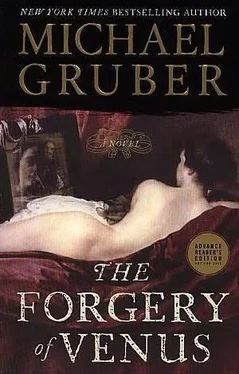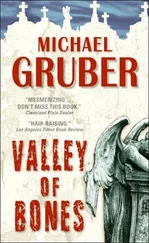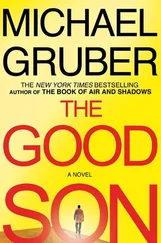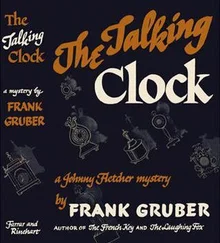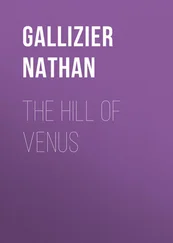So I followed him out like a wooden pull-toy and we traveled in the black car to Claude Demme on West Twenty-sixth Street. It was a three-man show by guys who were fifteen years younger than me; their work was about what you’d expect, and the people too, art hags, Eurotrash, dealers, a couple of A-list celebrities. Mark filled a plate with pricey sushi and started his usual schmoozing and air-kissing. I air-kissed not and filled my belly with champagne. After half a dozen flutes I felt the need for air and strolled out down the street toward Eighth Avenue.
All the galleries were lit, and I passed them without much interest until I came to a large storefront with a plaque on the wall that said ENSO GALLERY in artful calligraphy, white on black, and stopped to stare at a large painting in the window. It was of a nude woman unusually well rendered, and she was clutching tenderly to her breast a miniature version of herself, another spasm of irony wrung out of the corpse of surrealism, although the guy could really draw. It took me a couple of seconds to realize it was in exactly the same style as the unfinished piece I’d seen in the fancy loft. I stopped breathing and looked at the window card. It read RECENT WORK BY CHARLES WILMOT, JR., and sure enough, there was my monogram painted in the lower right of the painting.
I went in, shaking all over. There were a few people in the small white space and maybe ten paintings on the walls. All nudes, a few men, mostly women, more than a few young girls. The technique was realistic: flat lighting, concealing nothing, a good deal of crotch hair depicted, a soft-core effect, a little Balthus, a little Ron Mueck, a little Magritte. I recognized some of the models, women I’d known; Lotte and Suzanne were there too. The prices were up in the high five figures and quite a few had been sold. I’d never seen any of them in my life.
I went up to the girl behind the desk, a pretty blue-eyes with extra-large round spectacles and gelled punk-black hair. She looked up and gave me a big smile: “Hello, Mr. Wilmot,” she said, and I said, “What the hell is going on here?”
Her smile faded and she asked, “What do you mean?”
“You know me?” I demanded.
“Uh-huh.” Carefully. “Yeah, you’re the artist. Is something wrong?”
And I snapped.
The poor failed bastard I was in my every memory grew knuckle hair and tusks and shouted, “Is something wrong? Is something wrong ? Yeah, I’ll tell you what’s wrong, darling: I never painted any of this shit.”
I gave a yell and took out my knife and attacked the paintings, slashing through the beautiful, oh-so-salable surfaces, and my God, it felt good! The art lovers were screaming and running out and the girl screamed too and called out, “Serge!” and reached for the phone. I ran over to the window display and grabbed the card that had my name on it, and I was trying to slice it up with the knife when I was grabbed from behind by, I imagine, the Serge whom she’d called. The card with the knife still stuck in it fell from my hand as we struggled. I broke free and threw the first serious punch I’d let loose since the schoolyard, and he slipped it with an ease one doesn’t really expect in a gallery manager and connected with a left jab, then a powerful right cross, and I went down and out.
I came to in the back of a patrol car in handcuffs. Dimly, I observed a cop in conversation with Serge and the gallery clerk on the sidewalk, and then they drove me to what I assumed was their precinct and took my ID, watch, belt, and the laces from my sneakers away from me and put me in a cell, where I puked Claude Demme’s expensive champagne and some partly digested Chinese food all over myself.
Now I was officially a crazy person, and a dangerous one too. New York has a system for dealing with such emotionally disturbed people, as we are known, and I was now part of it. They are supposed to notify your next of kin, but when they asked I stayed mute. Many of us EDPs are similarly bereft, so it was no big deal. They shipped me to Bellevue with the vomit still caked on me, and there I was cleaned up, given a gown and a robe and paper slippers, shot full of Haldol, and left tied to a bed.
Some time passed. There was a painful swelling under the injection site on my shoulder, and I complained about it; they said they’d use the other arm if I needed another, but I was a good boy and didn’t make any trouble. A couple of days later, they switched me to pills and then I had my interview, fifteen minutes with an intern half my age. He asked me who I was and I told him I didn’t know. He asked me if I had someplace to go and I said I did. That was the magic answer, for it seemed that the Enso Gallery did not care to press charges. A little artistic misunderstanding, happens all the time. I got a scrip for olanzapine and a boot out the door, back into the world’s largest open-air aftercare facility, the streets of Manhattan.
Once there I fished my cell phone out of the envelope with my personal effects in it and brought up my phone book. It was my old one, with the art directors on it. Oh, good, I thought, the Haldol has kicked in. I called Mark.
He wanted to know where I’d been, and I said the mental ward at Bellevue, and he said, “Well, that was probably for the best. Are you back to being you?”
I said I was.
“You’re going to do my guy’s fresco, right?”
I said I would. In fact, I wanted to leave that very day.
“Not a problem,” he said. “I’ll call you.”
I went back to Walker Street, and my old door was there and my key worked. I looked around at the familiar environment, but it gave me no comfort. It was like I didn’t fit into that life anymore; it’s hard to explain, but I had the feeling that whatever happened I’d never live there again. I took a shower and dressed and packed a small bag. While I was packing, Mark called and told me I could pick up the tickets and the other stuff I’d need at his gallery that evening, and I did, and his black car took me to Kennedy and out of my old life.
They flew me to Venice on Alitalia, in first class. People complain about air travel a lot nowadays, but this was considerably better than being in Bellevue. I had a pint or two of Prosecco to start and the gnocchi alla Romana with a good enough Montepulciano. I was picked up at the airport as promised by a silent and efficient man who introduced himself as Franco, then taken by private launch to a boutique hotel off the Campo San Zaninovo, convenient to the palazzo, which is right on the Zaninovo Canal between the Ponte Storto and the Ponte Corona. I was just settling into my room when my cell phone rang, and it was Lotte calling. A renewed pang of terror and I refused the call. She left an angry message: according to her I should be in a psychiatric hospital and not swanning around Europe. She knew all about my recent craziness because someone at the gallery had used a cell phone camera to snap me being dragged from the gallery with blood all over my face, and it had made the tabloids, and she’d called Mark, who filled her in on the whole story, the rat. I didn’t return the call.
After a day of rest in my lovely room, Franco took me to the palazzo and turned me over to Signor Zuccone, who is the majordomo of the place and responsible to the big cheese for this abortion. Well, you know, it’s real damp in Venice, and the palazzo was built in 1512, and they probably spent fifty bucks on the roof since then, and when I looked up at the dining room ceiling I saw a sagging gray porridge, lightly smeared with angels and clouds. I told Zuccone that the whole thing had to come down. He didn’t blink, and the next day the demolishers were at work. While that was going on I had a look at Tiepolo’s cartoons. This was the actual working set, complete with the tiny holes and the marks of the red chalk pounce he’d used, miraculously preserved. So that was okay as far as the design went, which was an Assumption of the Virgin with angelic choir and saints, lots of lush clouds, no deep feeling, just pure gorgeousness. I loved it, and in a strange way it blew my recent identity problem right out of my skull. A consuming art project will do that sometimes, stifle the little voices of ego-or, in my case, madness-and let you exist in the realms of form and color when nothing’s of concern except the next stroke of the brush.
Читать дальше
